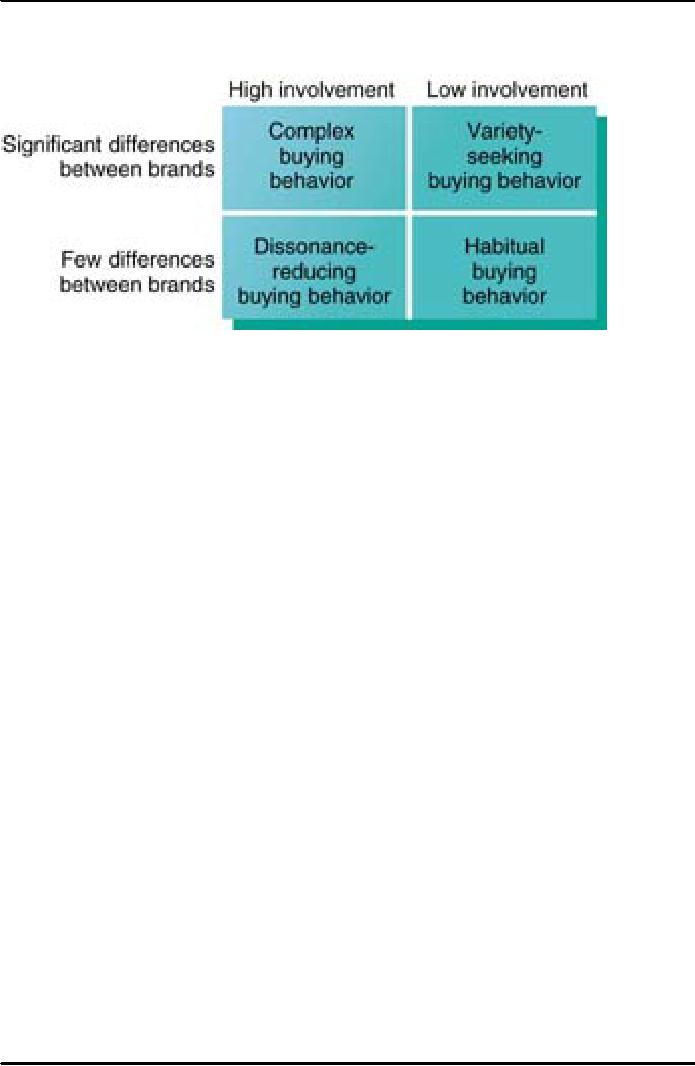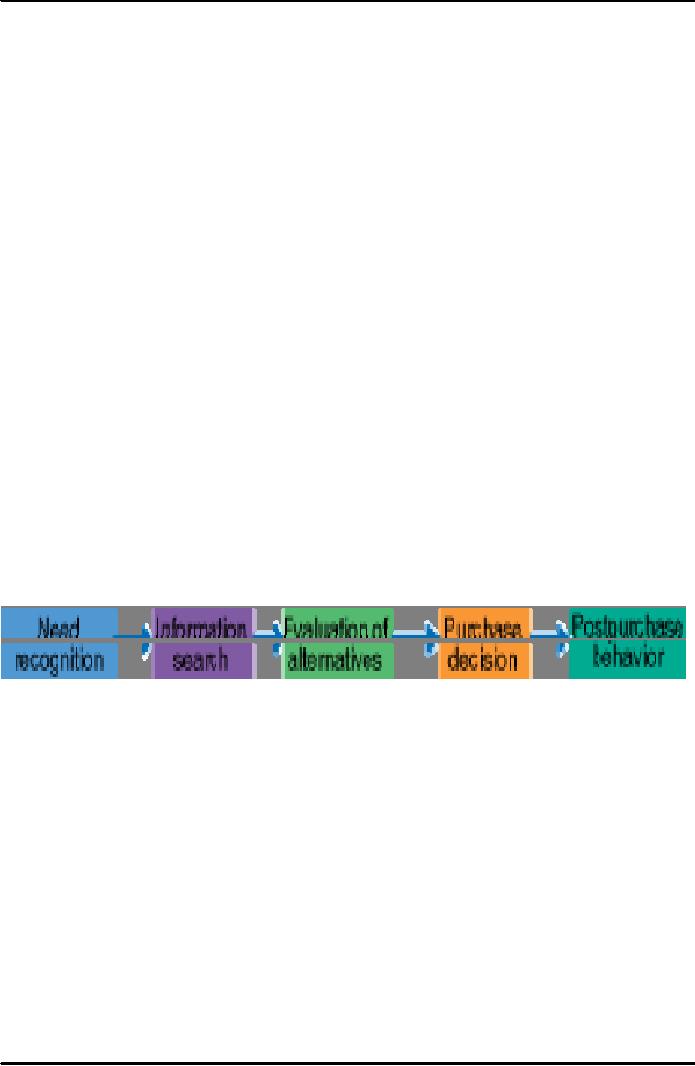 |

Principles
of Marketing MGT301
VU
Lesson
15
Lesson
overview and learning objectives:
In
last Lesson we discussed the
Consumer Buying behavior its model
and characteristics that
can
influence
the decision for buying
process. Today we will be
continuing the same topic
and will
discuss
the remaining factors that
influence the buying process
and decision of consumers.
So
our today's topic is:
CONSUMER
BUYING BEHAVIOR (CONTINUED):
c
Personal
Factors
A
buyer's decisions also are
influenced by personal characteristics
such as the buyer's age
and
life-
cycle
stage, occupation, economic situation,
lifestyle, and
personality
and
self-concept.
I.
Age and Life-Cycle
Stage
People
change the goods and
services they buy over
their lifetimes. Tastes in food,
clothes,
furniture,
and recreation are often age
related. Buying is also
shaped by the stage of the
family
life
cycle--the
stages through which families
might pass as they mature
over time. Marketers
often
define
their target markets in terms of
life-cycle stage and develop appropriate
products and
marketing
plans for each stage.
Traditional family life-cycle
stages include young singles
and
married
couples with
children.
II.
Occupation
A
person's occupation affects the
goods and services bought.
Blue-collar workers tend to
buy
more
rugged work clothes, whereas
white-collar workers buy
more business suits. Marketers
try to
identify
the occupational groups that have an
above-average interest in their products
and services.
A
company can even specialize
in making products needed by a given occupational
group. Thus,
computer
software companies will design
different products for brand
managers, accountants,
engineers,
lawyers, and doctors.
III.
Economic Situation
A
person's economic situation will
affect product choice. Marketers of
income-sensitive goods
watch
trends in personal income, savings,
and interest rates. If economic indicators
point to a
recession,
marketers can take steps to
redesign, reposition, and
reprice their products
closely.
IV.
Lifestyle
People
coming from the same
subculture, social class,
and occupation may have
quite different
lifestyles.
Life style is a person's pattern of
living as expressed in his or her
psychographics. It
involves
measuring consumers' major AIO
dimensions--activities
(work,
hobbies, shopping, sports,
social
events), interests
(food,
fashion, family, recreation), and
opinions
(about
themselves, social
issues,
business, products). Lifestyle
captures something more than
the person's social class
or
personality.
It profiles a person's whole
pattern of acting and
interacting in the
world.
Several
research firms have
developed lifestyle classifications. It
divides consumers into eight
groups
based on two major dimensions:
self-orientation and resources.
Self-orientation
groups
include
principle-oriented
consumers
who buy based on their views
of the world; status-oriented
buyers
who
base their purchases on the
actions and opinions of
others; and action-oriented
buyers
who are
driven
by their desire for
activity, variety, and risk taking.
Consumers within each
orientation are
further
classified into those with
abundant
resources and
those with minimal
resources, depending
on
whether
they have high or low
levels of income, education, health, self-confidence,
energy, and
other
factors. Consumers with either
very high or very low
levels of resources are
classified
without
regard to their self-orientations
(actualizers, strugglers). Actualizers
are people with so
66

Principles
of Marketing MGT301
VU
many
resources that they can
indulge in any or all self-orientations.
In contrast, strugglers
are
people
with too few resources to be
included in any consumer
orientation.
V.
Personality and
Self-Concept
Each
person's distinct personality influences
his or her buying behavior. Personality
refers to the
unique
psychological characteristics that lead
to relatively consistent and lasting
responses to one's
own
environment. Personality is usually
described in terms of traits such as
self-confidence,
dominance,
sociability, autonomy, defensiveness, adaptability,
and aggressiveness. Personality
can
be
useful in analyzing consumer behavior for
certain product or brand choices.
For example,
coffee
marketers have discovered
that heavy coffee drinkers tend to be
high on sociability. Thus,
to
attract customers, Starbucks and
other coffeehouses create
environments in which people
can
relax
and socialize over a cup of
steaming coffee.
Many
marketers use a concept related to
personality--a person's self-concept
(also
called self-image).
The
basic self-concept premise is that
people's possessions contribute to
and reflect their
identities;
that
is, "we are what we
have." Thus, in order to understand
consumer behavior, the marketer
must
first understand the relationship
between consumer self-concept and
possessions. For
example,
the founder and chief
executive of Barnes & Noble, the
nation's leading bookseller, notes
that
people buy books to support
their self-images:
d
Psychological
Factors
A
person's buying choices are
further influenced by four
major psychological factors: motivation,
perception,
learning, and
beliefs
and
attitudes.
I.
Motivation
A
person has many needs at any given
time. Some are biological,
arising
from states of tension
such
as
hunger, thirst, or discomfort.
Others are psychological,
arising
from the need for
recognition,
esteem,
or belonging. Most of these needs
will not be strong enough to
motivate the person to
act
at
a given point in time. A need
becomes a motive
when
it is aroused to a sufficient level
of
intensity.
A motive (or drive) is a
need that is sufficiently
pressing to direct the person to
seek
satisfaction.
Psychologists have developed
theories of human motivation. Two of
the most
popular--the
theories of Sigmund Freud and
Abraham Maslow--have quite
different meanings
for
consumer analysis and marketing.
II.
Maslow's Theory of
Motivation
1.
2.
Safety
Needs
Physiological
Needs
Physiological
Needs
4.
3.
Personal
Needs
Social
Needs
Social
Needs
Safety
Needs
Safety
Needs
Physiological
Needs
Physiological
Needs
67

Principles
of Marketing MGT301
VU
Abraham
Maslow sought to explain why
people are driven by
particular needs at particular
times.
Why
does one person spend much
time and energy on personal
safety and another on
gaining the
esteem
of others? Maslow's answer is that
human needs are arranged in
a hierarchy, from the
most
pressing
to the least pressing. Maslow's
hierarchy of needs is shown in Figure. In
order of
importance,
they are physiological
needs,
safety
needs,
social
needs,
esteem
needs,
and self-actualization
needs.
A person tries to satisfy the
most important need first.
When that need is satisfied,
it will
stop
being a motivator and the
person will then try to
satisfy the next most
important need. For
example,
starving people (physiological need)
will not take an interest in
the latest happenings
in
the
art world (self-actualization
needs), nor in how they
are seen or esteemed by
others (social or
esteem
needs), nor even in whether
they are breathing clean
air (safety needs). But as
each
important
need is satisfied, the next
most important need will
come into play.
III.
Perception
A
motivated person is ready to act.
How the person acts is
influenced by his or her own
perception
of
the situation. All of us learn by
the flow of information
through our five senses:
sight, hearing,
smell,
touch, and taste. However,
each of us receives, organizes,
and interprets this
sensory
information
in an individual way. Perception is the
process by which people
select, organize, and
interpret
information to form a meaningful
picture of the world.
People
can form different perceptions of
the same stimulus because of
three perceptual processes:
selective
attention, selective distortion,
and selective retention.
People are exposed to a
great
amount
of stimuli every day. For example,
the average person may be
exposed to more than
1,500
ads
in a single day. It is impossible for a
person to pay attention to all
these stimuli. Selective
attention--the
tendency for people to screen
out most of the information
to which they are
exposed--means
that marketers have to work
especially hard to attract
the consumer's attention.
Even
noted stimuli do not always
come across in the intended
way. Each person fits
incoming
information
into an existing mind-set. Selective
distortion describes
the tendency of people to
interpret
information in a way that will
support what they already
believe. Selective
distortion
means
that marketers must try to
understand the mind-sets of consumers and
how these will
affect
interpretations
of advertising and sales
information.
IV.
Learning
When
people act, they learn. Learning
describes changes in an individual's
behavior arising from
experience.
Learning theorists say that most
human behavior is learned. Learning
occurs through
the
interplay of drives,
stimuli, cues, responses, and
reinforcement.
V.
Beliefs and Attitudes
Through
doing and learning, people
acquire beliefs and attitudes.
These, in turn, influence
their
buying
behavior. A belief is a descriptive thought
that a person has about
something.
Buying
behavior differs greatly for a
tube of toothpaste, a tennis racket, an
expensive camera, and
a
new
car. More complex decisions
usually involve more buying
participants and more
buyer
deliberation.
Figure shows types of consumer buying
behavior based on the degree
of buyer
involvement
and the degree of differences
among brands.
C.
Types Buying Behaviors:
�
Complex
Buying Behavior
Consumers
undertake complex buying behavior
when they are highly
involved in a purchase
and
perceive
significant differences among brands.
Consumers may be highly
involved when the
product
is expensive, risky, purchased
infrequently, and highly
self-expressive. Typically,
the
consumer
has much to learn about the
product category. For example, a
personal computer
buyer
68

Principles
of Marketing MGT301
VU
may
not know what attributes to
consider. Many product features carry no
real meaning: a
"Pentium
Pro chip," "super VGA resolution," or
"megs of RAM."
This
buyer will pass through a
learning process, first developing
beliefs about the product,
then
attitudes,
and then making a thoughtful
purchase choice. Marketers of
high-involvement products
must
understand the information-gathering and
evaluation behavior of
high-involvement
consumers.
They need to help buyers learn
about product-class attributes and
their relative
importance,
and about what the company's
brand offers on the
important attributes. Marketers
need
to differentiate their brand's features,
perhaps by describing the brand's
benefits using print
media
with long copy. They
must motivate store
salespeople and the buyer's
acquaintances to
influence
the final brand
choice.
�
Dissonance-Reducing
Buying Behavior
Dissonance
reducing buying behavior occurs when
consumers are highly involved
with an
expensive,
infrequent, or risky purchase,
but see little difference among
brands. For example,
consumers
buying carpeting may face a
high-involvement decision because
carpeting is expensive
and
self-expressive. Yet buyers may
consider most carpet brands
in a given price range to be
the
same.
In this case, because
perceived brand differences are
not large, buyers may shop
around to
learn
what is available, but buy
relatively quickly. They may
respond primarily to a good price or
to
purchase
convenience.
After
the purchase, consumers might
experience post
purchase dissonance (after-sale
discomfort) when
they
notice certain disadvantages of the
purchased carpet brand or
hear favorable things
about
brands
not purchased. To counter such
dissonance, the marketer's
after-sale communications
should
provide evidence and support
to help consumers feel good about
their brand choices.
�
Habitual
Buying Behavior
Habitual
buying behavior occurs under
conditions of low consumer involvement
and little
significant
brand difference. For example,
take salt. Consumers have
little involvement in
this
product
category--they simply go to the
store and reach for a
brand. If they keep reaching
for the
same
brand, it is out of habit
rather than strong brand
loyalty. Consumers appear to
have low
involvement
with most low-cost,
frequently purchased
products.
In
such cases, consumer behavior does
not pass through the usual
belief-attitude-behavior
sequence.
Consumers do not search extensively
for information about the
brands, evaluate
brand
characteristics,
and make weighty decisions
about which brands to buy.
Instead, they
passively
receive
information as they watch
television or read magazines. Ad
repetition creates brand
familiarity
rather
than brand
conviction. Consumers
do not form strong attitudes
toward a brand; they
select
the brand because it is
familiar. Because they are
not highly involved with
the product,
consumers
may not evaluate the
choice even after purchase.
Thus, the buying process
involves
69

Principles
of Marketing MGT301
VU
brand
beliefs formed by passive learning,
followed by purchase behavior,
which may or may not
be
followed
by evaluation.
Because
buyers are not highly
committed to any brands, marketers of
low-involvement products
with
few brand differences often
use price and sales
promotions to stimulate product
trial. In
advertising
for a low-involvement product, ad
copy should stress only a
few key points.
Visual
symbols
and imagery are important
because they can be
remembered easily and
associated with the
brand.
Ad campaigns should include
high repetition of short-duration
messages. Television is
usually
more effective than print
media because it is a low-involvement
medium suitable for
passive
learning. Advertising planning should be
based on classical conditioning
theory, in which
buyers
learn to identify a certain product by a
symbol repeatedly attached to
it.
Marketers
can try to convert
low-involvement products into
higher-involvement ones by
linking
them
to some involving issue. Procter &
Gamble does this when it
links Crest toothpaste to
avoiding
cavities. At best, these
strategies can raise consumer
involvement from a low to
a
moderate
level. However, they are
not likely to propel the
consumer into highly involved
buying
behavior.
a.
Variety-Seeking Buying
Behavior
Consumers
undertake variety seeking buying
behavior in situations characterized by
low consumer
involvement
but significant perceived
brand differences. In such cases,
consumers often do a lot
of
brand
switching. For example, when
buying cookies, a consumer may
hold some beliefs, choose
a
cookie
brand without much
evaluation, then evaluate
that brand during
consumption. But the
next
time,
the consumer might pick another
brand out of boredom or
simply to try something
different.
Brand
switching occurs for the
sake of variety rather than
because of dissatisfaction.
In
such product categories, the marketing
strategy may differ for
the market leader and
minor
brands.
The market leader will try
to encourage habitual buying
behavior by dominating
shelf
space,
keeping shelves fully
stocked, and running
frequent reminder advertising. Challenger
firms
will
encourage variety seeking by
offering lower prices,
special deals, coupons, free samples,
and
advertising
that presents reasons for
trying something new.
D.
Buyer Decision
Process
Now
that we have looked at the
influences that affect buyers, we
are ready to look at
how
consumers
make buying decisions. Figure
shows that the buyer
decision process consists of
five
stages:
need
recognition, information search,
evaluation of alternatives, purchase
decision, and
post
purchase
behavior.
Clearly,
the buying process starts
long before actual purchase
and continues long
after.
Marketers
need to focus on the entire
buying process rather than
on just the purchase
decision.
The
figure implies that consumers pass
through all five stages
with every purchase. But in
more
routine
purchases, consumers often skip or
reverse some of these
stages. A woman buying
her
regular
brand of toothpaste would
recognize the need and go
right to the purchase
decision,
skipping
information search and
evaluation. However, we use
the model in Figure because
it
shows
all the considerations that
arise when a consumer faces a
new and complex
purchase
situation.
�
Need
Recognition
The
buying process starts with
need recognition--the buyer
recognizes a problem or need.
The
buyer
senses a difference between his or
her actual
state
and some desired
state.
The need can be
triggered
by internal
stimuli when
one of the person's normal
needs--hunger, thirst--rises to a
level
high
enough to become a drive. A
need can also be triggered
by external
stimuli. At
this stage, the
70

Principles
of Marketing MGT301
VU
marketer
should research consumers to
find out what kinds of needs
or problems arise, what
brought
them about, and how
they led the consumer to
this particular
product.
By
gathering such information, the marketer
can identify the factors
that most often trigger
interest
in
the product and can develop
marketing programs that involve
these factors.
�
Information
Search
An
aroused consumer may or may
not search for more
information. If the consumer's drive
is
strong
and a satisfying product is near at
hand, the consumer is likely to
buy it then. If not,
the
consumer
may store the need in
memory or undertake an information search
related to the need.
At
one level, the consumer may
simply enter heightened
attention. The
consumer can obtain
information
from any of several sources.
These include personal
sources (family,
friends, neighbors,
acquaintances),
commercial
sources (advertising,
salespeople, dealers, packaging,
displays, Web sites),
public
sources (mass
media, consumer-rating organizations),
and experiential
sources (handling,
examining,
using the product). The relative
influence of these information
sources varies with
the
product
and the buyer. Generally,
the consumer receives the
most information about a
product
from
commercial sources--those controlled by
the marketer. The most
effective sources,
however,
tend
to be personal. Commercial sources
normally inform
the
buyer, but personal sources
legitimize
or
evaluate
products
for the buyer.
People
often ask others--friends,
relatives, acquaintances,
professionals--for recommendations
concerning
a product or service. Thus,
companies have a strong interest in
building such word-of-
mouth
sources. These
sources have two chief
advantages. First, they are
convincing: Word of
mouth
is
the only promotion method
that is of
consumers,
by
consumers,
and for
consumers.
Having loyal,
satisfied
customers that brag about
doing business with you is
the dream of every business
owner.
Not
only are satisfied customers
repeat buyers, but they are
also walking, talking billboards
for
your
business. Second, the costs
are low. Keeping in touch
with satisfied customers and
turning
them
into word-of-mouth advocates
costs the business
relatively little.
As
more information is obtained, the
consumer's awareness and knowledge of the
available brands
and
features increases. The
information also helped her
drop certain brands from consideration.
A
company
must design its marketing mix to
make prospects aware of and
knowledgeable about its
brand.
It should carefully identify consumers'
sources of information and
the importance of
each
source.
Consumers should be asked
how they first heard
about the brand, what
information they
received,
and what importance they
placed on different information
sources.
�
Evaluation
of Alternatives
We
have seen how the consumer
uses information to arrive at a set of
final brand choices.
How
does
the consumer choose among
the alternative brands? The
marketer needs to know
about
alternatives
evaluation--that is, how the
consumer processes information to arrive at
brand
choices.
Unfortunately, consumers do not
use a simple and single
evaluation process in all
buying
situations.
Instead, several evaluation
processes are at
work.
The
consumer arrives at attitudes toward
different brands through
some evaluation procedure.
How
consumers go about evaluating purchase alternatives
depends on the individual
consumer
and
the specific buying
situation. In some cases, consumers
use careful calculations and
logical
thinking.
At other times, the same
consumers do little or no evaluating;
instead they buy on
impulse
and rely on intuition.
Sometimes consumers make buying
decisions on their
own;
sometimes
they turn to friends, consumer
guides, or salespeople for
buying advice.
Marketers
should study buyers to find
out how they actually
evaluate brand alternatives. If
they
know
what evaluative processes go on,
marketers can take steps to
influence the buyer's
decision.
�
Purchase
Decision
In
the evaluation stage, the
consumer ranks brands and
forms purchase intentions.
Generally, the
consumer's
purchase decision will be to
buy the most preferred
brand, but two factors
can come
between
the purchase intention
and
the purchase decision.
The
first factor is the
attitudes
of others. The
second
factor is unexpected
situational factors. The
consumer may form a purchase
intention based on
71

Principles
of Marketing MGT301
VU
factors
such as expected income, expected price,
and expected product benefits.
However,
unexpected
events may change the
purchase intention. Thus,
preferences and even
purchase
intentions
do not always result in
actual purchase
choice.
�
Post
purchase Behavior
The
marketer's job does not
end when the product is
bought. After purchasing the
product, the
consumer
will be satisfied or dissatisfied
and will engage in post
purchase behavior of interest to
the
marketer. What determines
whether the buyer is
satisfied or dissatisfied with a
purchase? The
answer
lies in the relationship
between the consumer's
expectations and
the product's perceived
performance.
If the
product falls short of expectations,
the consumer is disappointed; if it
meets
expectations,
the consumer is satisfied; if it exceeds
expectations, the consumer is delighted.
The
larger the gap between
expectations and performance, the
greater the consumer's
dissatisfaction.
This suggests that sellers
should make product claims
that faithfully represent
the
product's
performance so that buyers are satisfied.
Some sellers might even
understate
performance
levels to boost consumer satisfaction
with the product. For
example, Boeing's
salespeople
tend to be conservative when they
estimate the potential benefits of
their aircraft. They
almost
always underestimate fuel
efficiency--they promise a 5 percent
savings that turns out to
be
8
percent. Customers are delighted with
better-than-expected performance; they buy
again and tell
other
potential customers that Boeing lives up
to its promises.
Almost
all major purchases result
in cognitive dissonance, or discomfort
caused by post purchase
conflict.
After the purchase, consumers
are satisfied with the
benefits of the chosen brand
and are
glad
to avoid the drawbacks of the
brands not bought. However,
every purchase involves
compromise.
Consumers feel uneasy about acquiring
the drawbacks of the chosen
brand and
about
losing the benefits of the brands
not purchased. Thus,
consumers feel at least some
post
purchase
dissonance for every
purchase.
Why
is it so important to satisfy the
customer? Such satisfaction is important
because a company's
sales
come from two basic
groups--new
customers and
retained
customers. It
usually costs more to
attract
new customers than to retain current
ones, and the best way to
retain current customers is
to
keep them satisfied. Customer
satisfaction is a key to making lasting connections
with
consumers--to
keeping and growing consumers
and reaping their customer
lifetime value.
Satisfied
customers buy a product again,
talk favorably to others
about the product, pay
less
attention
to competing brands and advertising,
and buy other products
from the company.
Many
marketers
go beyond merely meeting
the
expectations of customers--they aim to
delight
the
customer.
A delighted customer is even more likely
to purchase again and to
talk favorably about
the
product and company.
A
dissatisfied consumer responds
differently. Whereas, on average, a
satisfied customer tells
3
people
about a good product
experience, a dissatisfied customer
gripes to 11 people. In fact,
one
study
showed that 13 percent of the
people who had a problem
with an organization complained
about
the company to more than 20
people. Clearly, bad word of
mouth travels farther and
faster
than
good word of mouth and
can quickly damage consumer attitudes
about a company and
its
products.
Therefore,
a company would be wise to
measure customer satisfaction regularly.
It cannot simply
rely
on dissatisfied customers to volunteer
their complaints when they
are dissatisfied. Some
96
percent
of unhappy customers never tell
the company about their
problem. Companies should
set
up
systems that encourage
customers to
complain. In this way, the
company can learn how well
it is
doing
and how it can improve.
The 3M Company claims that
over two-thirds of its
new-product
ideas
come from listening to
customer complaints. But
listening is not enough--the
company also
must
respond constructively to the complaints
it receives.
72

Principles
of Marketing MGT301
VU
�
The
Buyer Decision Process for
New Products
We
have looked at the stages
buyers go through in trying to satisfy a
need. Buyers may pass
quickly
or
slowly through these stages,
and some of the stages
may even be reversed. Much
depends on
the
nature of the buyer, the
product, and the buying
situation.
We
now look at how buyers
approach the purchase of new
products. A new product is a
good,
service,
or idea that is perceived by
some potential customers as new. It
may have been around
for
a
while, but our interest is in
how consumers learn about products
for the first time
and make
decisions
on whether to adopt them. We define the
adoption process as "the
mental process
through
which an individual passes
from first learning about an
innovation to final adoption,
and
adoption
as the
decision by an individual to become a
regular user of the
product.
Stages
in the Adoption Process
Consumers
go through five stages in
the process of adopting a new
product:
�
Awareness:
The
consumer becomes aware of the
new product, but lacks
information about
it.
�
Interest:
The
consumer seeks information about
the new product.
�
Evaluation:
The
consumer considers whether trying
the new product makes
sense.
�
Trial:
The
consumer tries the new
product on a small scale to improve his
or her estimate
of
its value.
�
Adoption:
The
consumer decides to make full
and regular use of the new
product.
This
model suggests that the
new-product marketer should think
about how to help
consumers
move
through these stages. A
manufacturer of large-screen televisions
may discover that
many
consumers
in the interest stage do not
move to the trial stage
because of uncertainty and
the large
investment.
If these same consumers were
willing to use a large-screen
television on a trial basis
for
a
small fee, the manufacturer
should consider offering a trial-use
plan with an option to
buy.
73
Table of Contents:
- PRINCIPLES OF MARKETING:Introduction of Marketing, How is Marketing Done?
- ROAD MAP:UNDERSTANDING MARKETING AND MARKETING PROCESS
- MARKETING FUNCTIONS:CUSTOMER RELATIONSHIP MANAGEMENT
- MARKETING IN HISTORICAL PERSPECTIVE AND EVOLUTION OF MARKETING:End of the Mass Market
- MARKETING CHALLENGES IN THE 21st CENTURY:Connections with Customers
- STRATEGIC PLANNING AND MARKETING PROCESS:Setting Company Objectives and Goals
- PORTFOLIO ANALYSIS:MARKETING PROCESS,Marketing Strategy Planning Process
- MARKETING PROCESS:Analyzing marketing opportunities, Contents of Marketing Plan
- MARKETING ENVIRONMENT:The Company’s Microenvironment, Customers
- MARKETING MACRO ENVIRONMENT:Demographic Environment, Cultural Environment
- ANALYZING MARKETING OPPORTUNITIES AND DEVELOPING STRATEGIES:MIS, Marketing Research
- THE MARKETING RESEARCH PROCESS:Developing the Research Plan, Research Approaches
- THE MARKETING RESEARCH PROCESS (Continued):CONSUMER MARKET
- CONSUMER BUYING BEHAVIOR:Model of consumer behavior, Cultural Factors
- CONSUMER BUYING BEHAVIOR (CONTINUED):Personal Factors, Psychological Factors
- BUSINESS MARKETS AND BUYING BEHAVIOR:Market structure and demand
- MARKET SEGMENTATION:Steps in Target Marketing, Mass Marketing
- MARKET SEGMENTATION (CONTINUED):Market Targeting, How Many Differences to Promote
- Product:Marketing Mix, Levels of Product and Services, Consumer Products
- PRODUCT:Individual product decisions, Product Attributes, Branding
- PRODUCT:NEW PRODUCT DEVELOPMENT PROCESS, Idea generation, Test Marketing
- NEW PRODUCT DEVELOPMENT:PRODUCT LIFE- CYCLE STAGES AND STRATEGIES
- KEY TERMS:New-product development, Idea generation, Product development
- Price the 2nd P of Marketing Mix:Marketing Objectives, Costs, The Market and Demand
- PRICE THE 2ND P OF MARKETING MIX:General Pricing Approaches, Fixed Cost
- PRICE THE 2ND P OF MARKETING MIX:Discount and Allowance Pricing, Segmented Pricing
- PRICE THE 2ND P OF MARKETING MIX:Price Changes, Initiating Price Increases
- PLACE- THE 3RD P OF MARKETING MIX:Marketing Channel, Channel Behavior
- LOGISTIC MANAGEMENT:Push Versus Pull Strategy, Goals of the Logistics System
- RETAILING AND WHOLESALING:Customer Service, Product Line, Discount Stores
- KEY TERMS:Distribution channel, Franchise organization, Distribution center
- PROMOTION THE 4TH P OF MARKETING MIX:Integrated Marketing Communications
- ADVERTISING:The Five M’s of Advertising, Advertising decisions
- ADVERTISING:SALES PROMOTION, Evaluating Advertising, Sales Promotion
- PERSONAL SELLING:The Role of the Sales Force, Builds Relationships
- SALES FORCE MANAGEMENT:Managing the Sales Force, Compensating Salespeople
- SALES FORCE MANAGEMENT:DIRECT MARKETING, Forms of Direct Marketing
- DIRECT MARKETING:PUBLIC RELATIONS, Major Public Relations Decisions
- KEY TERMS:Public relations, Advertising, Catalog Marketing
- CREATING COMPETITIVE ADVANTAGE:Competitor Analysis, Competitive Strategies
- GLOBAL MARKETING:International Trade System, Economic Environment
- E-MARKETING:Internet Marketing, Electronic Commerce, Basic-Forms
- MARKETING AND SOCIETY:Social Criticisms of Marketing, Marketing Ethics
- MARKETING:BCG MATRIX, CONSUMER BEHAVIOR, PRODUCT AND SERVICES
- A NEW PRODUCT DEVELOPMENT:PRICING STRATEGIES, GLOBAL MARKET PLACE